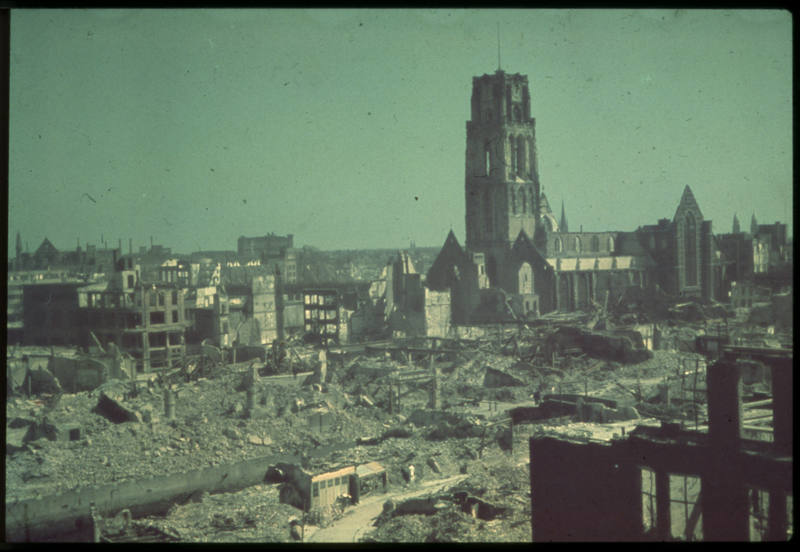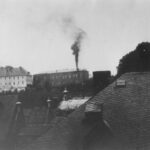Historical Essays
85 Years After the Flames: Remembering the Rotterdam Blitz
Eighty-five years ago, at 1:20 p.m. on May 14th, 1940, the Luftwaffe unleashed 97 tons of bombs over the city center of Rotterdam. Fierce fires broke out, merging into an inferno that lifted the roofs off houses, exploded windows, and caused cherry trees to bud, blossom, and blacken in minutes. My paternal grandmother, then 13, was huddled underground with her family as the ground heaved overhead; my maternal grandmother, aged 4, vividly recalled seeing the smoke of Rotterdam rising into the sky from miles away. She had been shopping in the city with her mother the day before.
The bombardment lasted fifteen minutes. The core of the 700-year-old city, including gabled houses from the Golden Age, guild-houses, and scores of other historic buildings, was reduced to black ruins. Nearly 1,000 people perished; 24,000 homes and 775 other buildings vanished. 80,000 were left homeless. In his travel memoir of pre-war Europe, A Time of Gifts, Patrick Leigh Fermor recalled walking through Rotterdam in the pre-dawn darkness and entering the St. Laurenskerk. “Except for this church, the beautiful city was to be bombed to fragments a few years later,” he wrote. “I would have lingered, had I known.”
While Europe celebrates V-E Day this month, the Netherlands marks both the anniversary of the Rotterdam Blitz and the 80th Liberation Day, with events taking place across Holland and Canada. Dutch people packed the streets in Apeldoorn and other cities to greet centenarian veterans from Canada, most of them now in wheelchairs, who had liberated them 80 years before. Many vets were taken aback by their hero’s welcome. “I’m a very ordinary person who has lived through many extraordinary events, but only by the grace of God,” said 102-year-old former Canadian flight lieutenant George Brewster. “And I’m humbled by this.”
The Dutch honor their Canadian liberators—7,600 of whom are buried in war cemeteries scattered across the country—because they keenly remember the Occupation. The Nazis invaded on May 10, 1940. They planned to take the country in four days, but met fierce resistance. On May 12th, Prince Bernhard, Princess Juliana, and their children fled the country on a British torpedo boat after the prince had personally fired his machine gun at low-flying German aircraft. Queen Wilhelmina and key government officials escaped on a British destroyer the following day. The Queen stayed in England. The princess and her children went on to Canada.
Fortress Holland, the strategic defensive area encompassing the western part of the Netherlands, prepared for an all-out assault on the morning of May 14th. More than two thousand Dutch troops moved in from three directions to repel the invaders. Furious, the German commander issued an ultimatum to the Dutch forces defending Rotterdam: Surrender by 12:00 p.m., or the city would be crushed from the sky. Talks began immediately; General Rudolf Schmidt agreed to delay the bombing with the Luftwaffe’s Heinkel HE 111 bombers already en route. Half of the 90 bombers did not receive the abort signal.
The fires blazed for days. My grandmother recalled that the rubble was still burning when they emerged from the air raid shelter; they saw that an elder from their church had pulled his teenage daughter from the ruins and laid her body gently on a vegetable cart. RAF Commodore Wilf Burnett, flying over the city on his way to bomb Germany on the night of May 15, recalled looking down from his plane and seeing the light from fires still dotting the black cityscape:
This was the first time I’d ever seen devastation by fires on this scale. We went right over the southern outskirts of Rotterdam at about 6,000 or 7,000 feet, and you could actually smell the smoke from the fires burning on the ground. I was shocked, seeing a city in flames like that. Devastation on a scale I had never experienced.
The Germans threatened to flatten Utrecht and other cities, and the Dutch capitulated on May 15th. The province of Zeeland held out for two more days, surrendering on May 17th. Thus began the five long years of the Occupation. My four grandparents—each of whom lived in different areas of the Netherlands—would occasionally tell their grandchildren of those dark times, describing in color scenes we automatically imagined in black and white. Nazi roundups. ‘Onderduikers’ hidden in the attic. Ration cards. V-2s heading to Germany from England falling short. Family members shipped to forced labor camps in the Reich. Fear.
The families of all four of my grandparents were liberated by the First Canadian Army, commanded by Lieutenant-General Charles Foulkes, who would accept the German surrender on May 5th, 1945, at the Hotel de Wereld in Wageningen. My grandmother recalls a neighbor suddenly tapping on their window, saying: “We’re free! We’re free!” The family knelt to say a prayer of thanks; her mother went upstairs to retrieve the long-stowed Dutch flag and orange banners. There was a last-minute tragedy; a retreating German soldier shot and killed a local woman who had been in the resistance as she hung a flag from their windmill.
READ THE REST OF THIS ESSAY AT THE EUROPEAN CONSERVATIVE








